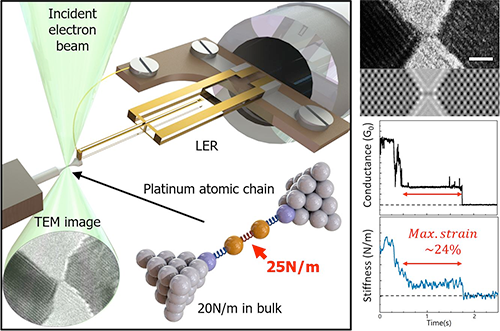| May 14, 2021 |
Hanging by a thread: Imaging and probing chains of single atoms
(Nanowerk News) Low-dimensional materials, such as 1D monoatomic chains, exhibit exotic properties that could find interesting applications. However, single-atom bonds and their mechanical characteristics are difficult to study.
|
|
In a recent study, scientists from JAIST, Japan, showcase a novel method to simultaneously image monoatomic platinum chains with a transmission electron microscope while measuring their bond strength and conductance during mechanical stretching. This technique will help answer many questions in the fields of nanomechanics and surface science.
|
|
Today, many well-studied materials in various fields, such as electronics and catalysis, are close to reaching their practical limits. To further improve upon modern technology and outperform state-of-the-art devices, researchers looking for new functional materials have to push the boundaries and explore more extreme cases. A clear example of this is the study of low-dimensional materials, such as monoatomic layers (2D materials) and monoatomic chains (1D materials).
|
|
It has been proved time and time again that low-dimensional materials exhibit exotic properties that are absent in their 3D bulk counterparts. For example, monoatomic chains of metals like gold and platinum (Pt) can exhibit the contribution of certain quantum phenomena, such as magnetic order or thermal transport, in ways that could find practical applications. However, it is very difficult to experimentally observe what goes on in monoatomic chains composed of five or less atoms, and the mechanical properties of single-atom bonds remain elusive.
|
|
To tackle this issue, a research group lead by Professor Yoshifumi Oshima from Japan Advanced Institute of Science and Technology (JAIST), Japan, is pioneering a novel and promising technique to measure the strength of individual atomic bonds. Their latest study, which was published in Nano Letters ("Peculiar Atomic Bond Nature in Platinum Monatomic Chains") and showcased their strategy, involved researchers from JAIST (Dr. Zhang, Dr. Ishizuka, Prof. Tomitori, Prof. Maezono and Prof. Hongo), as well as Prof. Arai from Kanazawa University and Prof. Tosatti from the International School for Advanced Studies (SISSA) and The Abdus Salam International Centre for Theoretical Physics (ICTP).
|
 |
| Microscopic nanomechanics measurement method. (left) Schematic illustration of the technique. The stiffness of nanomaterials such as platinum (Pt) atomic chains can be measured using a length-extension resonator (LER) made with a quartz crystal. The atomic structure of the chain can be observed using a transmission electron microscope (TEM). We found that the atomic bond strength in the Pt monoatomic chains is 25 N/m, which is higher than the bulk value (20 N/m). (right) Experimental and simulated TEM images of a monoatomic Pt chain and time evolution of its electrical conductance and stiffness during stretching. The maximum strain was 24% on average. (Image: JAIST) (click on image to enlarge)
|
|
This new technique, which Oshima named the “microscopic nanomechanics measurement method,” combines transmission electron microscopy (TEM) with a quartz length-extension resonator (LER). TEM is a widely used imaging technique with incredibly high spatial resolution—enough to make out individual atoms—whereas the LER is a device that can oscillate at incredibly small amplitudes of a few ten trillionths of a meter and serves as a force sensor.
|
|
The researchers devised an experimental setup in which a small Pt juncture was stretched to its absolute breaking point, that is, when the two pieces of Pt were linked by a monoatomic chain of two to five atoms. By carefully aligning the pieces in the TEM, they observed the formation and breaking of the monoatomic Pt chains in real time.
|
|
Moreover, using the quartz LER, they measured the conductance across the chain and its stiffness, from which the strength of individual Pt bonds was calculated with success.
|
|
“We found the bond strength of 25 N/m in the monoatomic Pt chains to be remarkably high, especially compared to the 20 N/m normally found in bulk Pt crystals,” comments Zhang. “Moreover, these single-atom bonds could be stretched about 24% of their regular distance, in stark contrast to the 5% that bonds between Pt atoms in bulk can be stretched,” he adds.
|
|
The results of the study showcase the potential of this novel technique to probe monoatomic chain bonds, which could lead to a better understanding of the interfaces or surfaces of low-dimensional materials.
|
|
“Our method could greatly contribute to the design of advanced materials and catalysts as well as shed light on nanoscale phenomena in terms of surface or interface nanomechanics,” highlights Oshima.
|
|
In turn, more sophisticated materials and a better understanding of their surface properties will undoubtedly advance the fields of electronics, chemistry, and nanotechnology, paving the way to innovative and hopefully sustainable designs.
|

